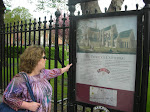I attended a webinar which is a seminar, lecture, or interactive conference hosted on the web, in this case at the hosting site called Elluminate. Richard Byrne a local celebrity/teacher from Maine introduced and led the topic of back-channeling in the classroom. The term Back-channeling was first coined in 1970 by Victor Yngve, a Massachusetts Institute Of Technology (MIT) professor in the area of linguistic who used the term to identify the short messages such as, yes, head nods, and uh-huh that the person speaking receives from the listener indicating attention and understanding. Technology’s version of the back-channel is slightly different because there are actual conversations occurring outside of the lecture. It is similar to passing notes in class while your instructor is talking but with technology back-channels that type of behavior is accepted and encouraged.
This is how the webinar worked with Richard Byrne speaking during a slide show of the topic but the best part is that while that while he is presenting there is a side bar in which participants can Instant Message (IM) to presenters and other participants without disruption to the presentation. I did not participate in the sidebar chat as this was a first experience and things were moving very quickly. Even though I only listened into the Webinar I still felt like I got a lot out of the experience. How does back-channeling look in the classroom?
The back-channel is an open real time chat channel available for student’s questions and comments occurring during the course of instruction. It is truly amazing! Think about showing a movie in class and you need to stop it for students to ask questions or to provide students with a missing connection in the content. No more interruptions or disruptions because now those conversations can take place in the back-channel and not interrupting the flow of the lesson/movie. Websites available to use for back-channeling are as follows:
Wave.google.com
Edmodo.com
Micromobs.com
Todaysmeet.com
Hootcourse.com
Neatchat.com
Friendfeed.com
Chatzy.com
Tinychat.com
Stinto.net
Snapgroups.com
Twitter can also be used if the back-channel is open to everyone on the web.
You can enjoy the entire webinar at slideshare. Additional resources available from Derek Bruff posting on the 9 uses of back-channel in education which include:
Sharing resources
Commenting
Amplifying
Asking questions
Helping one another
Offering suggestions
Building community
Opening the classroom
Lastly consider Cliff Atkinson's new Book, The Backchannel.

No comments:
Post a Comment